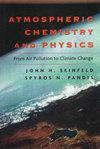中国典型城市地区 PM2.5 中的水不溶性有机碳:光吸收特性、潜在来源、辐射强迫效应以及可能的光吸收连续体
IF 5.1
1区 地球科学
Q1 ENVIRONMENTAL SCIENCES
引用次数: 0
摘要
摘要。水不溶性有机碳(WIOC)是有机碳(OC)的重要组成部分,对褐碳(BrC)的光吸收起着重要作用,在气候强迫中起着举足轻重的作用。中国是OC和BrC含量较高的热点地区,但有关全国范围内WIOC的来源和光吸收特性的信息仍然很少。在此,我们调查了中国 10 个代表性城市中 WIOC 的光吸收特性和来源。在可萃取OC(EX-OC)的浓度和365 nm波长光吸收率(Abs365)中,WIOC平均占33.4 ± 7.66 %和40.5 ± 9.73 %,EX-OC包括相对疏水性OC(WIOC和类腐殖质,HULIS-C)和亲水性OC(非类腐殖质,non-HULIS-C)。WIOC 在 365 纳米波长下的质量吸收效率(MAE365)为(1.59 ± 0.55 m2 (g C)-1),与 HULIS(1.54 ± 0.57 m2 (g C)-1)相当,但明显高于非 HULIS(0.71 ± 0.28 m2 (g C)-1),表明疏水性 OC 比亲水性 OC 具有更强的光吸收能力。生物质燃烧(31.0%)和煤炭燃烧(31.1%)是 WIOC 的主要来源,其中煤炭燃烧的光吸收能力最强。此外,利用简单强迫效率(SFE300-700 nm)法,我们观察到 WIOC 在 EX-OC 分馏物中表现出最高的 SFE300-700 nm(6.57 ± 5.37 W g-1)。EX-OC的辐射强迫主要来自疏水OC(WIOC - 39.4 ± 15.5 %,HULIS - 39.5 ± 12.1 %)。考虑到不同碳质成分的芳香度、来源和大气过程,我们提出了一个光吸收碳质连续体,揭示了富含化石来源的成分往往具有更强的光吸收能力、更高的芳香度、更大的分子量以及在大气中更大的再脆性。减少化石燃料排放是减缓气态(二氧化碳)和颗粒吸光碳质变暖成分的有效手段。本文章由计算机程序翻译,如有差异,请以英文原文为准。
The water-insoluble organic carbon in PM2.5 of typical Chinese urban areas: light-absorbing properties, potential sources, radiative forcing effects, and a possible light-absorbing continuum
Abstract. Water-insoluble organic carbon (WIOC) constitutes a substantial portion of organic carbon (OC) and contributes significantly to light absorption by brown carbon (BrC), playing pivotal roles in climate forcing. China is a hotspot region with high levels of OC and BrC, but information regarding the sources and light-absorbing properties of WIOC on a national scale remains scarce. Here, we investigated the light-absorbing properties and sources of WIOC in 10 representative urban cities in China. On average, WIOC made up 33.4 ± 7.66 % and 40.5 ± 9.73 % of concentrations and light absorption at 365 nm (Abs365) of extractable OC (EX-OC), which includes relatively hydrophobic OC (WIOC and humic-like substances, HULIS-C) and hydrophilic OC (non-humic-like substances, non-HULIS-C). The mass absorption efficiency of WIOC at 365 nm (MAE365) was (1.59 ± 0.55 m2 (g C)−1) comparable to that of HULIS (1.54 ± 0.57 m2 (g C)−1) but significantly higher than non-HULIS (0.71 ± 0.28 m2 (g C)−1), indicating that hydrophobic OC possesses a stronger light-absorbing capacity than hydrophilic OC. Biomass burning (31.0 %) and coal combustion (31.1 %) were the dominant sources of WIOC, with coal combustion sources exhibiting the strongest light-absorbing capacity. Moreover, employing the simple forcing efficiency (SFE300–700 nm) method, we observed that WIOC exhibited the highest SFE300–700 nm (6.57 ± 5.37 W g−1) among the EX-OC fractions. The radiative forcing of EX-OC was predominantly contributed by hydrophobic OC (WIOC – 39.4 ± 15.5 % and HULIS – 39.5 ± 12.1 %). Considering the aromaticity, sources, and atmospheric processes of different carbonaceous components, we propose a light-absorbing carbonaceous continuum, revealing that components enriched with fossil sources tend to possess stronger light-absorbing capacity, higher aromatic levels, increased molecular weights, and greater recalcitrance in the atmosphere. Reducing fossil fuel emissions emerges as an effective means of mitigating both gaseous (CO2) and particulate light-absorbing carbonaceous warming components.
求助全文
通过发布文献求助,成功后即可免费获取论文全文。
去求助
来源期刊

Atmospheric Chemistry and Physics
地学-气象与大气科学
CiteScore
10.70
自引率
20.60%
发文量
702
审稿时长
6 months
期刊介绍:
Atmospheric Chemistry and Physics (ACP) is a not-for-profit international scientific journal dedicated to the publication and public discussion of high-quality studies investigating the Earth''s atmosphere and the underlying chemical and physical processes. It covers the altitude range from the land and ocean surface up to the turbopause, including the troposphere, stratosphere, and mesosphere.
The main subject areas comprise atmospheric modelling, field measurements, remote sensing, and laboratory studies of gases, aerosols, clouds and precipitation, isotopes, radiation, dynamics, biosphere interactions, and hydrosphere interactions. The journal scope is focused on studies with general implications for atmospheric science rather than investigations that are primarily of local or technical interest.
 求助内容:
求助内容: 应助结果提醒方式:
应助结果提醒方式:


